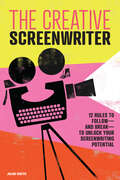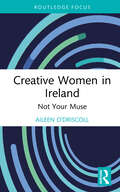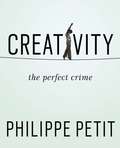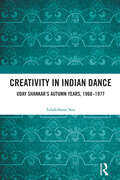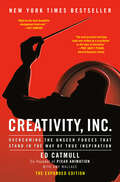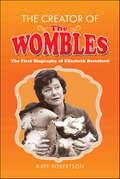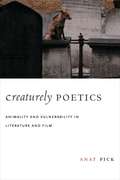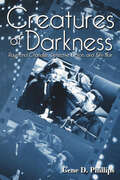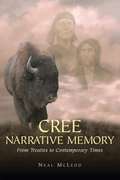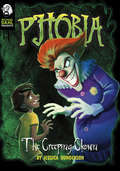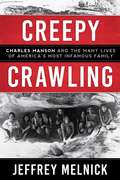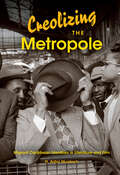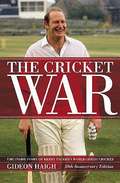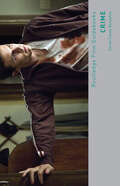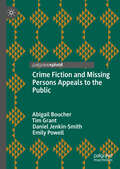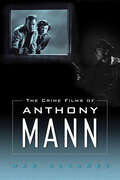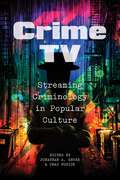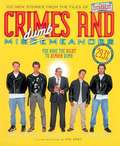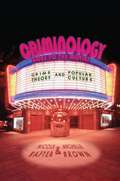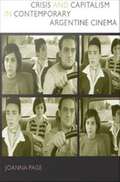- Table View
- List View
The Creative Screenwriter: 12 Rules to Follow—and Break—to Unlock Your Screenwriting Potential
by Julian HoxterMaster the craft of screenwriting—12 steps to bring your creative vision to the screen It can be difficult to find a modern resource that teaches you the nuts and bolts of screenwriting while also allowing you the freedom to creatively thrive. This guide distills the craft of screenwriting into 12 key elements, from developing your story to revising and rewriting, plus plenty of inspiration to create your own screenplay with confidence. Discover what to expect within the film industry and how it has evolved. Look behind the scenes at iconic films using a classic structure of screenwriting, along with experimental films from innovative writers that have transcended the rules and paved their own way to the silver screen. Then, get to the exciting part—writing—using a dozen tried-and-true rules of the trade. Each chapter is accompanied with an In the Writer's Room creative exercise, such as formatting your script, mapping sequences, and creating rich dialogue and characters, to deepen your understanding of what brings a screenplay to life. This screenwriting guide includes: Filmmaker's dozen—From loglines to creating a compelling character to root for, you'll find 12 fundamental but flexible steps to help you craft a powerful, creative screenplay. Topline terminology—Navigate the film biz like a pro with need-to-know Hollywood jargon, plus troubleshooting tips for any screenwriting hiccups along the way. Film archive—From William Goldman's The Princess Bride to Taika Waititi's Jojo Rabbit, discover emerging and timeless screenwriting techniques used in Hollywood blockbusters, micro-budget films, and more. Take your story from creative conception to complete script with this modern, 12-step approach to screenwriting.
Creative Women in Ireland: Not Your Muse (Routledge Focus on the Global Creative Economy)
by Aileen O'DriscollThrough the contributions of women working in the creative industries, this timely book explores the role of creativity in their lives, the experiences that have positively contributed to and supported their creativity and their work, as well as how gendered considerations intersect with their involvement in the cultural sphere. Spanning psychology, cultural and media studies, and the philosophy of art, it builds on existing research by offering examples of the abundance of creativity residing in women working in film and television, architecture, design, music, theatre, and the performing and visual arts in Ireland. Their reflections offer a valuable counter perspective to the assumption that women are more naturally the ‘muse’ than the creator. From these conversations, some common, although at times diverging, experiences in childhood, early career and approaches to their creative work offer important insights into the nature and practice of creativity and the conditions that may best nurture and support creativity in girls and women. Providing original observations into gendered understandings of creativity, this book will be essential reading for researchers, advanced students and practitioners seeking contemporary insights on creativity, feminism and gender.
Creativity
by Philippe PetitIn the vein of The Creative Habit and The Artist's Way, a new manifesto on the creative process from a master of the impossible. Since well before his epic 1974 walk between the Twin Towers of the World Trade Center, Philippe Petit had become an artist who answered first and foremost to the demands of his craft--not only on the high wire, but also as a magician, street juggler, visual artist, builder, and writer. A born rebel like many creative people, he was from an early age a voracious learner who taught himself, cultivating the attitudes, resources, and techniques to tackle even seemingly impossible feats. His outlaw sensibility spawned a unique approach to the creative process--an approach he shares, with characteristic enthusiasm, irreverence, and originality in Creativity: The Perfect Crime. Making the reader his accomplice, Petit reveals new and unconventional ways of going about the artistic endeavor, from generating and shaping ideas to practicing and problem-solving to pulling off the "coup" itself--executing a finished work. The strategies and insights he shares will resonate with performers of every stripe (actors, musicians, dancers) and practitioners of the non-performing arts (painters, writers, sculptors), and also with ordinary mortals in search of fresh ways of tackling the challenges and possibilities of everyday existence.
Creativity and Copyright: Legal Essentials for Screenwriters and Creative Artists
by John L. Geiger Howard SuberInspired by Strunk & White's The Elements of Style, this elegant, short reference is the perfect guide for screenwriters and creative artists looking to succeed as industry professionals. Readers will quickly understand the laws that govern creativity, idea-making, and selling, and learn how to protect themselves and their works from the legal quagmires they may encounter. Written by an unrivaled pair of experts, John L. Geiger and Howard Suber, who use real-life case studies to cover topics such as clearance, contracts, collaboration, and infringement, Creativity and Copyright is poised to become an indispensable resource for beginners and experts alike.
Creativity in Indian Dance: Uday Shankar's Autumn Years, 1960 – 1977
by Sulakshana SenHeralded as the father of Indian Creative Dance, and India’s cultural ambassador, Uday Shankar (1900–1977) was a dancer and choreographer who created a vibrant new Indian dance form without any ethno-regional centricity. Over time, Shankar’s art evolved from being a representation of the exotic East, to a narrative of modern India. This book provides a detailed study of Shankar’s works in his autumn years (1960–1977), which remain largely un-documented. It discusses the form and content of Shankar’s style, and its basic tenets - something hitherto unexplored. It also analyses Rabindranath Tagore and Uday Shankar as path-breakers of the duality in Indian performing arts traditions. The productions explored in detail are Samanya Kshati (1961), Shankar’s tour of USA, Canada and Europe in 1962, and India’s cultural diplomacy, as well as Prakriti Ananda (1966), Shankar’s last tour of USA (1968), his last masterpiece, Shankarscope (1970, 1971 and 1972), together with Shankar's legacy. This book is an essential read for scholars and researchers of dance history, art history, critical theory, artists' biographies, creative arts studies, theatre and Asian performing arts studies as well as students of International Relations theory – primarily those interested in cultural diplomacy and soft power.
Creativity, Inc.: Overcoming the Unseen Forces That Stand in the Way of True Inspiration
by Ed Catmull Amy WallaceFrom Ed Catmull, co-founder (with Steve Jobs and John Lasseter) of Pixar Animation Studios, comes an incisive book about creativity in business—sure to appeal to readers of Daniel Pink, Tom Peters, and Chip and Dan Heath.Creativity, Inc. is a book for managers who want to lead their employees to new heights, a manual for anyone who strives for originality, and the first-ever, all-access trip into the nerve center of Pixar Animation—into the meetings, postmortems, and &“Braintrust&” sessions where some of the most successful films in history are made. It is, at heart, a book about how to build a creative culture—but it is also, as Pixar co-founder and president Ed Catmull writes, &“an expression of the ideas that I believe make the best in us possible.&”For nearly twenty years, Pixar has dominated the world of animation, producing such beloved films as the Toy Story trilogy, Monsters, Inc., Finding Nemo, The Incredibles, Up, and WALL-E, which have gone on to set box-office records and garner thirty Academy Awards. The joyousness of the storytelling, the inventive plots, the emotional authenticity: In some ways, Pixar movies are an object lesson in what creativity really is. Here, in this book, Catmull reveals the ideals and techniques that have made Pixar so widely admired—and so profitable.As a young man, Ed Catmull had a dream: to make the first computer-animated movie. He nurtured that dream as a Ph.D. student at the University of Utah, where many computer science pioneers got their start, and then forged a partnership with George Lucas that led, indirectly, to his founding Pixar with Steve Jobs and John Lasseter in 1986. Nine years later, Toy Story was released, changing animation forever. The essential ingredient in that movie&’s success—and in the thirteen movies that followed—was the unique environment that Catmull and his colleagues built at Pixar, based on philosophies that protect the creative process and defy convention, such as:• Give a good idea to a mediocre team, and they will screw it up. But give a mediocre idea to a great team, and they will either fix it or come up with something better.• If you don&’t strive to uncover what is unseen and understand its nature, you will be ill prepared to lead. • It&’s not the manager&’s job to prevent risks. It&’s the manager&’s job to make it safe for others to take them.• The cost of preventing errors is often far greater than the cost of fixing them. • A company&’s communication structure should not mirror its organizational structure. Everybody should be able to talk to anybody.• Do not assume that general agreement will lead to change—it takes substantial energy to move a group, even when all are on board.
Creativity, Inc.: Overcoming the Unseen Forces That Stand in the Way of True Inspiration
by Amy Wallace Ed CatmullCreativity, Inc. is a book for managers who want to lead their employees to new heights, a manual for anyone who strives for originality, and the first-ever, all-access trip into the nerve center of Pixar Animation—into the meetings, postmortems, and “Braintrust” sessions where some of the most successful films in history are made. It is, at heart, a book about how to build a creative culture—but it is also, as Pixar co-founder and president Ed Catmull writes, “an expression of the ideas that I believe make the best in us possible.”<P><P> For nearly twenty years, Pixar has dominated the world of animation, producing such beloved films as the Toy Story trilogy, Monsters, Inc., Finding Nemo, The Incredibles, Up, and WALL-E, which have gone on to set box-office records and garner thirty Academy Awards. The joyousness of the storytelling, the inventive plots, the emotional authenticity: In some ways, Pixar movies are an object lesson in what creativity really is. Here, in this book, Catmull reveals the ideals and techniques that have made Pixar so widely admired—and so profitable.<P> As a young man, Ed Catmull had a dream: to make the first computer-animated movie. He nurtured that dream as a Ph.D. student at the University of Utah, where many computer science pioneers got their start, and then forged a partnership with George Lucas that led, indirectly, to his founding Pixar with Steve Jobs and John Lasseter in 1986. Nine years later, Toy Story was released, changing animation forever. The essential ingredient in that movie’s success—and in the thirteen movies that followed—was the unique environment that Catmull and his colleagues built at Pixar, based on philosophies that protect the creative process and defy convention, such as:<P> * Give a good idea to a mediocre team, and they will screw it up. But give a mediocre idea to a great team, and they will either fix it or come up with something better.<P> * If you don’t strive to uncover what is unseen and understand its nature, you will be ill prepared to lead. <P> * It’s not the manager’s job to prevent risks. It’s the manager’s job to make it safe for others to take them.<P> * The cost of preventing errors is often far greater than the cost of fixing them. <P> * A company’s communication structure should not mirror its organizational structure. Everybody should be able to talk to anybody.<P> Chosen for Mark Zuckerberg's "A Year of Books"
Creativity, Inc. (The Expanded Edition): Overcoming the Unseen Forces That Stand in the Way of True Inspiration
by Ed Catmull Amy WallaceThe co-founder and longtime president of Pixar updates and expands his 2014 New York Times bestseller on creative leadership, reflecting on the management principles that built Pixar&’s singularly successful culture, and on all he learned during the past nine years that allowed Pixar to retain its creative culture while continuing to evolve.&“Might be the most thoughtful management book ever.&”—Fast Company For nearly thirty years, Pixar has dominated the world of animation, producing such beloved films as the Toy Story trilogy, Finding Nemo, The Incredibles, Up, and WALL-E, which have gone on to set box-office records and garner eighteen Academy Awards. The joyous storytelling, the inventive plots, the emotional authenticity: In some ways, Pixar movies are an object lesson in what creativity really is. Here, Catmull reveals the ideals and techniques that have made Pixar so widely admired—and so profitable. As a young man, Ed Catmull had a dream: to make the first computer-animated movie. He nurtured that dream as a Ph.D. student, and then forged a partnership with George Lucas that led, indirectly, to his founding Pixar with Steve Jobs and John Lasseter in 1986. Nine years later, Toy Story was released, changing animation forever. The essential ingredient in that movie&’s success—and in the twenty-five movies that followed—was the unique environment that Catmull and his colleagues built at Pixar, based on philosophies that protect the creative process and defy convention, such as:• Give a good idea to a mediocre team and they will screw it up. But give a mediocre idea to a great team and they will either fix it or come up with something better.• It&’s not the manager&’s job to prevent risks. It&’s the manager&’s job to make it safe for others to take them.• The cost of preventing errors is often far greater than the cost of fixing them.• A company&’s communication structure should not mirror its organizational structure. Everybody should be able to talk to anybody.Creativity, Inc. has been significantly expanded to illuminate the continuing development of the unique culture at Pixar. It features a new introduction, two entirely new chapters, four new chapter postscripts, and changes and updates throughout. Pursuing excellence isn&’t a one-off assignment but an ongoing, day-in, day-out, full-time job. And Creativity, Inc. explores how it is done.
The Creator of the Wombles: The First Biography of Elisabeth Beresford
by Kate RobertsonThis is the extraordinary story of Elisabeth Beresford, creator of The Wombles, the furry, fun-loving recyclers of rubbish which became a children’s publishing and television sensation in the 1970s. What drove this imaginative and prolific writer of children’s books to invent The Wombles? From her birth in Paris in 1926 to her death in the Channel Islands in 2010, Beresford’s working life was led to the full, driven by the fear of debt. Married to the TV and radio sports commentator, Max Robertson, and with two children, Elisabeth’s life was never dull but always uncertain. In addition to writing over 140 children’s books, she wrote romantic fiction for women’s magazines, became a regular contributor to the Today program, Woman’s Hour (BBC) and Woman’s World (Central Office of Information). As a journalist she interviewed a fascinating range of people from politicians and film stars to children in the remote Australian Outback. With the publication of The Wombles, and subsequently the enchanting BBC films, Elisabeth found fame and for a very brief moment, fortune. This is the first biography of ‘Mrs Womble’ as Elisabeth was known by millions of fans. Written by her daughter with insider knowledge and access to private family archives - diaries, letters, photographs and family memories - this book relates the remarkable and often hilarious life of one of the 20th century’s most successful children’s authors.
Creaturely Poetics: Animality and Vulnerability in Literature and Film
by Anat PickSimone Weil once wrote that "the vulnerability of precious things is beautiful because vulnerability is a mark of existence," establishing a relationship between vulnerability, beauty, and existence transcending the separation of species. Her conception of a radical ethics and aesthetics could be characterized as a new poetics of species, forcing a rethinking of the body's significance, both human and animal. Exploring the "logic of flesh" and the use of the body to mark species identity, Anat Pick reimagines a poetics that begins with the vulnerability of bodies, not the omnipotence of thought. Pick proposes a "creaturely" approach based on the shared embodiedness of humans and animals and a postsecular perspective on human-animal relations. She turns to literature, film, and other cultural texts, challenging the familiar inventory of the human: consciousness, language, morality, and dignity. Reintroducing Weil's elaboration of such themes as witnessing, commemoration, and collective memory, Pick identifies the animal within all humans, emphasizing the corporeal and its issues of power and freedom. In her poetics of the creaturely, powerlessness is the point at which aesthetic and ethical thinking must begin.
Creatures of Darkness: Raymond Chandler, Detective Fiction, and Film Noir
by Gene D. Phillips“[An] exhaustively researched survey of Raymond Chandler’s thorny relationship with Hollywood during the classic period of film noir.” —Alain Silver, film producer and authorRaymond Chandler’s seven novels, including The Big Sleep (1939) and The Long Goodbye (1953), with their pessimism and grim realism, had a direct influence on the emergence of film noir. Chandler worked to give his crime novels the flavor of his adopted city, Los Angeles, which was still something of a frontier town, rife with corruption and lawlessness. In addition to novels, Chandler wrote short stories and penned the screenplays for several films, including Double Indemnity (1944) and Strangers on a Train (1951). His work with Billy Wilder and Alfred Hitchcock on these projects was fraught with the difficulties of collaboration between established directors and an author who disliked having to edit his writing on demand.Creatures of Darkness is the first major biocritical study of Chandler in twenty years. Gene Phillips explores Chandler’s unpublished script for Lady in the Lake, examines the process of adaptation of the novel Strangers on a Train, discusses the merits of the unproduced screenplay for Playback, and compares Howard Hawks’s director’s cut of The Big Sleep with the version shown in theaters. Through interviews he conducted with Wilder, Hitchcock, Hawks, and Edward Dmytryk over the past several decades, Phillips provides deeper insight into Chandler’s sometimes difficult personality.Chandler’s wisecracking private eye, Philip Marlowe, has spawned a thousand imitations. Creatures of Darkness lucidly explains the author’s dramatic impact on both the literary and cinematic worlds, demonstrating the immeasurable debt that both detective fiction and the neo-noir films of today owe to Chandler’s stark vision.
Cree Narrative Memory: From Treaties To Contemporary Times
by Neal McLeodNeal McLeod examines the history of the nêhiyawak (Cree People) of western Canada from the massive upheavals of the 1870s and the reserve period to the vibrant cultural and political rebirth of contemporary times. Central to the text are the narratives of McLeod's family, which give first hand examples of the tenacity and resiliency of the human spirit while providing a rubric for reinterpreting the history of Indigenous people, drawing on Cree worldviews and Cree narrative structures. <p><p> In a readable style augmented with extensive use of the Cree language throughout, McLeod draws heavily on original research, the methodology of which could serve as a template for those doing similar work. While the book is based on the Cree experience of the Canadian prairies, its message and methodology are applicable to all Indigenous societies.
The Creeping Clown: A Tale of Terror (Michael Dahl Presents: Phobia)
by Jessica GundersonCoulrophobia--the fear of clowns. It might seem funny, but for Josh this fear is no joke. Josh has a pulse-pounding, sweat-inducing feeling about the clown that advertises the local pizza place. Or anyone who dresses up as a clown for Halloween. When a class field trip takes him to an amusement park, Josh's friends dare him to enter the Hall of Horrors. Will one of those horrors be wearing a frizzy wig and a red nose? Josh is on his guard, but then someone else gets into trouble and needs help. Can Josh muster the courage to conquer his greatest fear and come to the rescue?
Creepy Crawling: Charles Manson and the Many Lives of America's Most Infamous Family
by Jeffrey Melnick"Creepy crawling" was the Manson Family's practice of secretly entering someone's home and, without harming anyone, leaving only a trace of evidence that they had been there, some reminder that the sanctity of the private home had been breached. Now, author Jeffrey Melnick reveals just how much the Family creepy crawled their way through Los Angeles in the sixties and then on through American social, political, and cultural life for close to fifty years, firmly lodging themselves in our minds. Even now, it is almost impossible to discuss the sixties, teenage runaways, sexuality, drugs, music, California, and even the concept of family without referencing Manson and his "girls." Not just another history of Charles Manson, Creepy Crawling explores how the Family weren't so much outsiders but emblematic of the Los Angeles counterculture freak scene, and how Manson worked to connect himself to the mainstream of the time. Ever since they spent two nights killing seven residents of Los Angeles-what we now know as the "Tate-LaBianca murders"-the Manson family has rarely slipped from the American radar for long. From Emma Cline's The Girls to the recent TV show Aquarius, the family continues to find an audience. What is it about Charles Manson and his family that captivates us still? Author Jeffrey Melnick sets out to answer this question in this fascinating and compulsively readable cultural history of the Family and their influence from 1969 to the present.
Creolizing the Metropole: Migrant Caribbean Identities In Literature And Film (Blacks In The Diaspora Ser.)
by H. Adlai MurdochCreolizing the Metropole is a comparative study of postwar West Indian migration to the former colonial capitals of Paris and London. It studies the effects of this population shift on national and cultural identity and traces the postcolonial Caribbean experience through analyses of the concepts of identity and diaspora. Through close readings of selected literary works and film, H. Adlai Murdoch explores the ways in which these immigrants and their descendants represented their metropolitan identities. Though British immigrants were colonial subjects and, later, residents of British Commonwealth nations, and the French arrivals from the overseas departments were citizens of France by law, both groups became subject to otherness and exclusion stemming from their ethnicities. Murdoch examines this phenomenon and the questions it raises about borders and boundaries, nationality and belonging.
The Cricket War by Gideon Haigh
by Gideon HaighIn May 1977, the cricket world awoke to discover that a thirty-nine-year-old Sydney businessman called Kerry Packer had signed thirty-five elite international players for his own televised 'World Series'. The Cricket War is the definitive account of the split that changed the game on the field and on the screen. In helmets, under lights, with white balls, and in coloured clothes, the outlaw armies of Ian Chappell, Tony Greig and Clive Lloyd fought a daily battle of survival. In boardrooms and courtrooms Packer and cricket's rulers fought a bitter war of nerves. A compelling account of the top-class sporting life, The Cricket War also gives a unique insight into the motives and methods of the man who became Australia's richest, and remained so, until the day he died. It was the end of cricket as we knew it – and the beginning of cricket as we know it. Gideon Haigh has published over thirty books, over twenty of them about cricket. This edition of The Cricket War, Gideon Haigh's first book about cricket originally published in 1993, has been updated since.
Crime (Routledge Film Guidebooks)
by Sarah Casey BenyahiaCrime films have, since the earliest days of cinema, been popular with audiences, industry and critics alike and encompassed a diverse range of subjects, styles and themes. The genre provides a range of pleasures for the spectator, from taking on the role of the detective in the pursuit of clues in the ‘whodunit’, to the more illicit thrills of identification with an anti hero. In the many incarnations of the crime film such as the gangster, film noir, political and detective thrillers, the genre explores the anxieties of different historical moments. Sarah Casey Benyahia provides an overview of the development of the crime film and examines the key theories and ideas involved in the study of the genre. These include; the investigative structure and narration of the crime film, the aesthetics of violence and issues of representation and ideology. These areas are explored through contemporary and classic, Hollywood and European cinema with case studies on the history of the genre, the role of the detective, the 'family crime' film and the conspiracy thriller. Crime provides a broad framework to the study of the genre through the introduction of narrative, genre and audience theories as well as detailed analysis of specific films. Films discussed include: Scarface (1932) Mildred Pierce (1945) Dirty Harry (1971) The Parallax View (1974) Reservoir Dogs (1992) Mystic River (2002) Hidden (2005) Gone Baby Gone (2007) Zodiac (2007) The Millennium Trilogy (2009) The Secret in Their Eyes (2010)
Crime Fiction and Missing Persons Appeals to the Public
by Abigail Boucher Tim Grant Daniel Jenkin-Smith Emily PowellThis book draws upon genre fiction studies, forensic linguistics, and media studies to investigate the overlap between crime fiction conventions and the writing of missing persons appeals to the public. This book is based on a pilot project funded by the Aston Institute for Forensic Linguistics, entitled 'Genre, Pacing, and Narrative in Police Missing Persons Appeals' (Aug 2021-Nov 2022). The authors identify a missing persons appeal as a literary and linguistic genre in its own right and illustrate the problems that arise when the appeals writing process goes unregulated or unstudied: there is currently little-to-no official, national police guidance, regulation, or standard procedure for writing a missing persons appeal in the UK. The authors also identify opportunities for improving the writing and delivery of appeals by further (and more intentionally) applying crime fiction conventions, narrative devices, and pacing, to maximise audience reach and increase the chances of recovering a missing person. This book will be of particular interest to genre fiction scholars (particularly those interested in crime fiction), forensic linguists, and media studies scholars.
The Crime Films of Anthony Mann
by Max AlvarezAnthony Mann (1906–1967) is renowned for his outstanding 1950s Westerns starring James Stewart (Winchester '73, The Naked Spur, The Man from Laramie). But there is more to Mann's cinematic universe than those tough Wild West action dramas featuring conflicted and secretive heroes. This brilliant Hollywood craftsman also directed fourteen electrifying crime thrillers between 1942 and 1951, among them such towering achievements in film noir as T-Men, Raw Deal, and Side Street. Mann was as much at home filming dark urban alleys in black-and-white as he was the prairies and mountains in Technicolor, and his protagonists were no less conflicted and secretive than his 1950s cowboys. In these Mann crime thrillers we find powerful stories of sexual obsession (The Great Flamarion), the transforming images of women in wartime and postwar America (Strangers in the Night, Strange Impersonation), exploitation of Mexican immigrants (Border Incident), studies of the criminal mind (He Walked by Night), and Civil War bigotry (The Tall Target). Mann's forceful camera captured such memorable and diverse stars as Erich von Stroheim, Farley Granger, Dennis O'Keefe, Claire Trevor, Richard Basehart, Ricardo Montalbán, Ruby Dee, and Raymond Burr. The Crime Films of Anthony Mann features analysis of rare documents, screenplays, story treatments, and studio memoranda and reveals detailed behind-the-scenes information on preproduction and production on the Mann thrillers. Author Max Alvarez uses rare and newly available sources to explore the creation of these noir masterworks. Along the way, the book exposes secrets and solves mysteries surrounding the mercurial director and his remarkable career, which also included Broadway and early live television.
Crime TV: Streaming Criminology in Popular Culture
by Ben Jones Eduardo MendietaFrom Game of Thrones to Breaking Bad, the key theories and concepts in criminal justice are explained through the lens of televisionIn Crime TV, Jonathan A. Grubb and Chad Posick bring together an eminent group of scholars to show us the ways in which crime—and the broader criminal justice system—are depicted on television. From Breaking Bad and Westworld to Mr. Robot and Homeland, this volume highlights how popular culture frames our understanding of crime, criminological theory, and the nature of justice through modern entertainment. Featuring leading criminologists, Crime TV makes the key concepts and analytical tools of criminology as engaging as possible for students and interested readers. Contributors tackle an array of exciting topics and shows, taking a fresh look at feminist criminology on The Handmaid’s Tale, psychopathy on The Fall, the importance of social bonds on 13 Reasons Why, radical social change on The Walking Dead, and the politics of punishment on Game of Thrones. Crime TV offers a fresh and exciting approach to understanding the essential concepts in criminology and criminal justice and how theories of crime circulate in popular culture.
Crimes and Misdumbmeanors: 100 New Stories from the Files of America's Dumbest Criminals
by Daniel R. Butler Alan Ray Larry RoseCRIMES AND MISDUMBMEANERS contains 100 stories of idiots such as * The thief who stole some loot from a car and then slammed the locked door- on his thumb. It stayed locked until the police arrived and arrested him. * An Indianapolis man urho robbed a gun from his neighbor's house. The gun didn't work and so he broke in again to return it. A robber who was told by a teller that she didn't have as much money as he wanted and it would take a few minutes to get it together. The man waited patiently while the teller got the money - and the police. * The homeowner who called 911 when he captured a thief on his property. The stolen goods were "my best marijuana plants." Police arrested the thief and the homeowner
Criminalization/Assimilation: Chinese/Americans and Chinatowns in Classical Hollywood Film
by Philippa GatesCriminalization/Assimilation traces how Classical Hollywood films constructed America’s image of Chinese Americans from their criminalization as unwanted immigrants to their eventual acceptance when assimilated citizens, exploiting both America’s yellow peril fears about Chinese immigration and its fascination with Chinatowns. Philippa Gates examines Hollywood’s responses to social issues in Chinatown communities, primarily immigration, racism, drug trafficking, and prostitution, as well as the impact of industry factors including the Production Code and star system on the treatment of those subjects. Looking at over 200 films, Gates reveals the variety of racial representations within American film in the first half of the twentieth century and brings to light not only lost and forgotten films but also the contributions of Asian American actors whose presence onscreen offered important alternatives to Hollywood’s yellowface fabrications of Chinese identity and a resistance to Hollywood’s Orientalist narratives.
Criminals as Heroes in Popular Culture
by Kathryn E. Lane Roxie J. JamesThis book delves into humanity’s compulsive need to valorize criminals. The criminal hero is a seductive figure, and audiences get a rather scopophilic pleasure in watching people behave badly. This book offers an analysis of the varied and vexing definitions of hero, criminal, and criminal heroes both historically and culturally. This book also examines the global presence, gendered complications, and gentle juxtapositions in criminal hero figures such as: Robin Hood, Breaking Bad, American Gods, American Vandal, Kabir, Plunkett and Macleane, Martha Stewart, Mary Read, Anne Bonny, Ocean’s 11, Ocean’s Eleven, and Let The Bullets Fly.
Criminology Goes to the Movies: Crime Theory and Popular Culture
by Nicole Rafter Michelle BrownA &“deftly written and absorbing&” look at how films reflect concepts in criminology and affect our perceptions of criminal behavior (Richard Rosenfeld, coauthor of Crime and the American Dream). From Psycho to Double Indemnity to Thelma & Louise, Nicole Rafter and Michelle Brown show that criminological theory is produced not only in the academy through scholarly research, but also in popular culture through film. Criminology Goes to the Movies connects with ways in which students are already thinking criminologically through engagements with popular culture, encouraging them to use the everyday world as a vehicle for theorizing and understanding both crime and perceptions of criminality. The first work to bring a systematic and sophisticated criminological perspective to bear on crime films, Rafter and Brown&’s book provides a fresh way of looking at cinema using the concepts and analytical tools of criminology to uncover previously unnoticed meanings in film, ultimately making the study of criminological theory more engaging and effective for students while simultaneously demonstrating how theories of crime circulate in our mass-mediated worlds. With chapters focusing on films including Do the Right Thing, Capturing the Friedmans, and more, the result is an illuminating new way of seeing movies and a delightful way of learning about criminology.
Crisis and Capitalism in Contemporary Argentine Cinema
by Joanna PageThere has been a significant surge in recent Argentine cinema, with an explosion in the number of films made in the country since the mid-1990s. Many of these productions have been highly acclaimed by critics in Argentina and elsewhere. What makes this boom all the more extraordinary is its coinciding with a period of severe economic crisis and civil unrest in the nation. Offering the first in-depth English-language study of Argentine fiction films of the late twentieth century and early twenty-first, Joanna Page explains how these productions have registered Argentina's experience of capitalism, neoliberalism, and economic crisis. In different ways, the films selected for discussion testify to the social consequences of growing unemployment, rising crime, marginalization, and the expansion of the informal economy. Page focuses particularly on films associated with New Argentine Cinema, but she also discusses highly experimental films and genre movies that borrow from the conventions of crime thrillers, Westerns, and film noir. She analyzes films that have received wide international recognition alongside others that have rarely been shown outside Argentina. What unites all the films she examines is their attention to shifts in subjectivity provoked by political or economic conditions and events. Page emphasizes the paradoxes arising from the circulation of Argentine films within the same global economy they so often critique, and she argues that while Argentine cinema has been intent on narrating the collapse of the nation-state, it has also contributed to the nation's reconstruction. She brings the films into dialogue with a broader range of issues in contemporary film criticism, including the role of national and transnational film studies, theories of subjectivity and spectatorship, and the relationship between private and public spheres.
